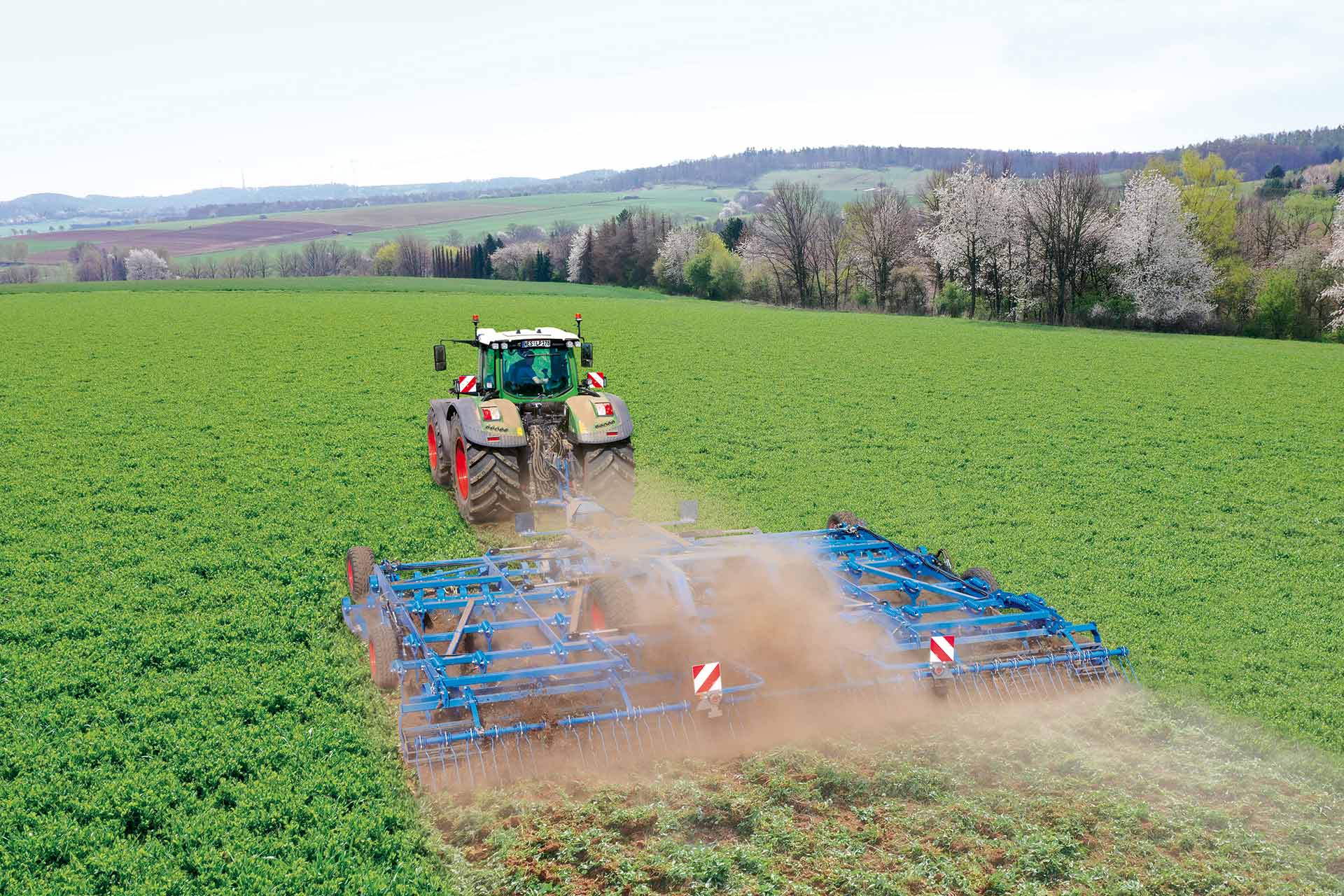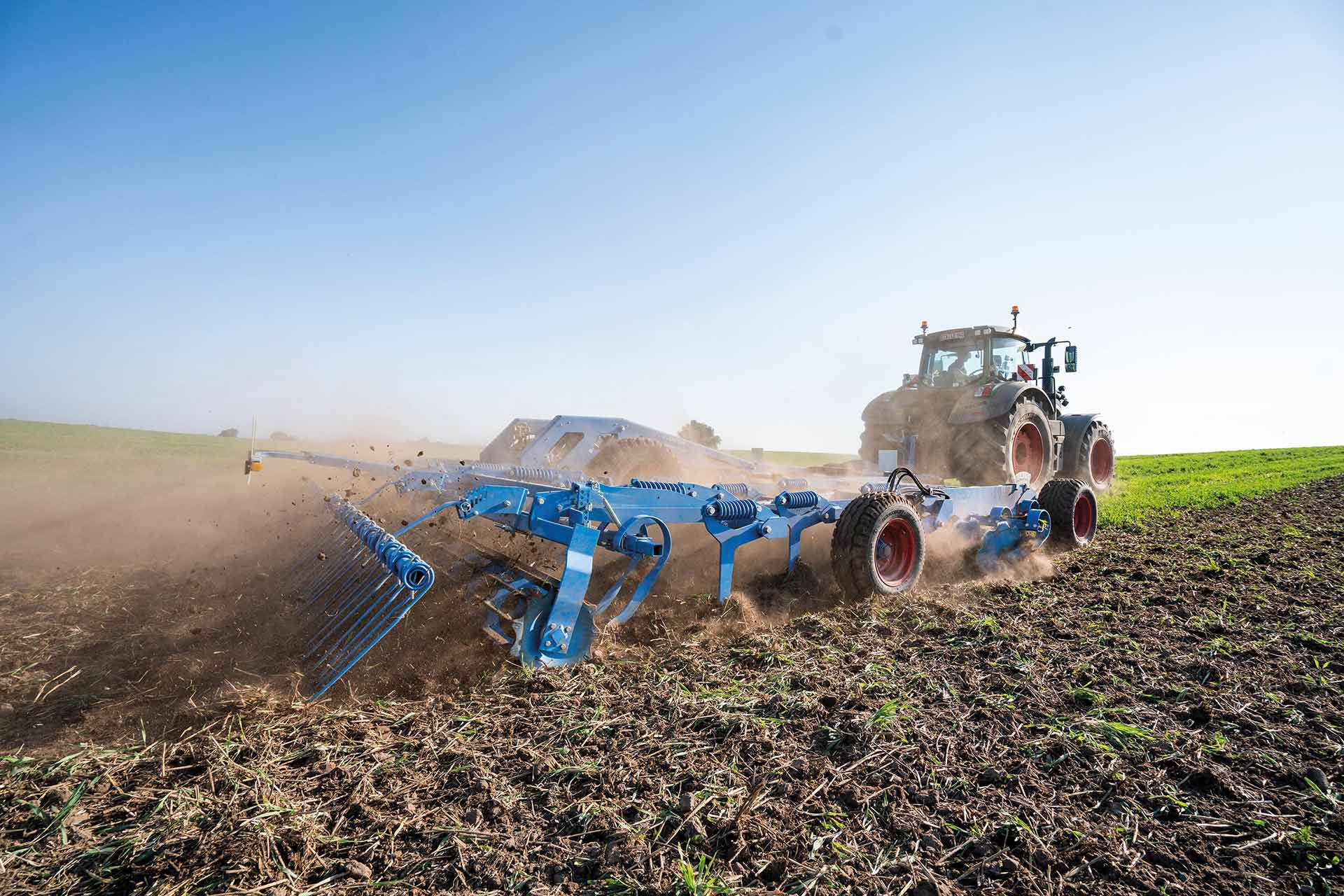
Tillage in spring and stubble cultivation in summer have one thing in common: they should be carried out as shallow as possible whilst as deep as necessary. In the spring, this primarily preserves the structure of the soil and conserves its water supply. In summer, the water argument becomes more important. The Koralin was designed to meet these demands as well as being a highly efficient tool for mechanical weed control over the entire area.

Every farmer knows the situation: After months of winter dormancy on the farmland, they are itching to finally get active outdoors again. But caution is called for with any form of soil cultivation. Despite all the digitalisation, the soil structure and moisture should first be assessed with a spade. After all, nothing is worse than driving over and cultivating soil that is too wet with a heavy tractor, especially on medium and heavy sites.
Use machines depending on location and situation
When choosing the appropriate tillage technology, it depends on the intended purpose and the respective conditions at the location. Currently, farmers mainly work relatively intensively with cultivators and short disc harrows.
If, for example, a catch crop is still standing on the field before sowing the summer crop, in practice it is usually chopped up and mixed into the soil. This should be done evenly without blockages and heaps so that the organic matter does not hinder the following sowing and decomposes quickly.

If the area has greened itself over winter, it is advisable to remove the growth. This can be done chemically or mechanically. The chemical option with products containing glyphosate will probably only be possible in the EU until the end of 2023, with a transitional period. In addition, more and more products for weed control in crops are being discontinued. Therefore, many practitioners are already considering how greening can be mechanically eliminated. Row crops such as sugar beet should, if possible, be sown on a clean seedbed.

Water is becoming more and more precious
The availability of water also significantly influences the choice of tillage. Basically, the deeper, more intensive and more frequently the soil is cultivated, the more water evaporates before it benefits plant growth. The experience of the last few years in particular has shown that when water-conserving methods are used, the crops last longer in dry spells. Often, only shallow tillage is required before sowing the summer crop, which should be based on the sowing depth. This is common practice on many farms, especially if the soil was loosened more deeply in dry conditions the previous year, for example, before sowing the catch crop.
Care in stubble cultivation
It is also important to conserve soil water during stubble cultivation. This can then be used efficiently for the germination of volunteer cereals and weed seeds as well as for a subsequent catch crop. To do this, the previous crop root system must be cut off and residues well mixed to allow decomposition. An ultra-flat working method conserves the water supply! This principle for the first stubble cultivation applies especially to rape stubble. Rape seeds that are buried too deeply fall into dormancy and run into the following crops if disturbed during seeding.


Compared to the first stubble cultivation, the second pass should be worked a little deeper in order to use the soil as resistance for safe, comprehensive cutting.
A harrow as the last working element in the implement assembly brings the worked out weeds to the surface where they dry out. Tap rooted weeds like Docks are a particular challenge. They can be significantly reduced by cutting them off several times.

Observe interactions
The interactions between tillage and nitrogen mineralisation must also be taken into account. Intensive tillage brings air and heat into the soil and thus favours the activity of bacteria that convert organically bound nitrogen into a form available to plants. Less intensive tillage delays mineralisation. Ideally, the control is such that the main supply of mineralised nitrogen can be utilised by the main crop.
Koralin 9 complements LEMKEN product range
LEMKEN offers the right machines for all kinds of tillage requirements. In addition to ploughs, cultivators, short disc harrows, power harrows or seedbed combinations, there is now a new development that points the way to the future. The Koralin cultivator combines the advantages of a disc harrow and a cultivator in one implement. It can be optimally used in spring work and for stubble cultivation.

Discs and tines harmonise with each other
The Koralin is characterised by a vertically operating front disc unit and a rear tine unit that cuts horizontally over the entire area. With this combination, an volunteer crop, for example, can be chopped, mixed into the soil and undercut over the entire surface, so that no new sprouting can take place. The discs are arranged in such a way that they each work exactly in front of the coulter tip and the coulter wings of the A share style, self-sharpening DeltaCut coulters. This makes it easier for the coulters to penetrate the soil and reduces wear, traction requirements and the susceptibility to blockages. In addition, hard metal armouring of the coulters ensures a long-lasting high quality of work.
The Koralin is just as successful when it comes to removing old weeds in spring or volunteer cereals, legumes and rape in autumn. It is thus the mechanical alternative to the application of a total herbicide. An optional four-row harrow does a good job in this context. The tines bring the fine roots and weeds to the surface, where they dry out. Alternatively, the Koralin can be equipped with three different rollers for reconsolidation and a single-row following harrow.
Flat is preceded by ultra-flat

The great strength of the Koralin is its fuel-efficient, ultra-flat mode of operation. From a working depth of just 2 centimetres, it works the soil over the entire surface. Neither shallow cultivators nor short disc harrows can compete with this. Several feeler and support wheels as well as the movable side parts of the semi-mounted machine enable safe and precise depth control even on slopes. The shallow depth and intensity of the shearing of the plant root capillaries just below the soil surface sustainably protect the water balance. Another effect of the working method: It protects the soil from erosion. The cultivator is the machine of choice for working depths up to 12 cm and working speeds up to 12 km/h.
“The crucial thing is that I can use the right machine at the 100 per cent right time“
Johannes Müller, Farmer from Lower Saxony

The farmer from Etzenborn in Lower Saxony therefore no longer wants to do without Koralin. It is used, among other things, after mild winters in unfrozen oil radish-yellow mustard intercropping stands. The coulters cut the oil radish roots just below the soil surface and prevent resprouting. In addition, he uses the cultivator in spring for winter pea and clover grass ploughing or to keep the land black without intercropping. Müller farms according to Bioland guidelines. “The more weeds that can be controlled directly or preventively with machinery, the better. Because this reduces the effort required for hand weeding in his vegetable crops and sugar beet. In summer, Koralin is the first choice for the first and second stubble cultivation after cereals and field beans. Even repeated use, according to the farm manager, does not result in noticeable
Thoughts on soil water
- Every intervention in the soil leads to an increased interface between soil and atmosphere, where water can evaporate unproductively!
- A low intensity of intervention in the soil and leaving crop residues on the soil surface conserves the water supply in the soil.
- A mulch layer breaks the capillarity and supports the water-saving effect.
- Organic matter lying on the surface or placed close to the surface protects the soil from the direct impact of raindrops and reduces their kinetic energy. Siltation and erosion processes are stopped! The water can be optimally used by the plant.
Prof. Dr. Ulrich Groß, Weihenstephan-Triesdorf University of Applied Sciences, Germany